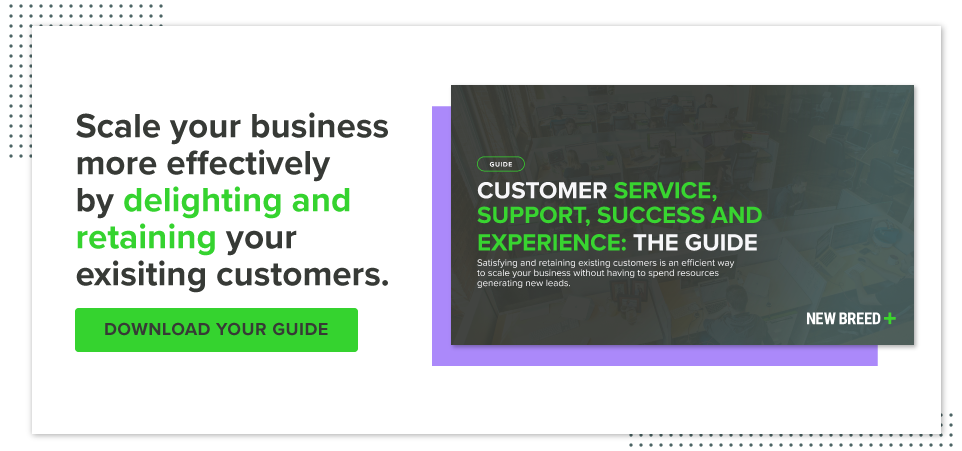How to Map Customer Journey Touchpoints to Improve Customer Experience
For a business to be successful, it needs customers who stick around — and with increasing levels of competition with other products and services, customer retention is harder than ever.
To enable the most sustainable growth, you don’t want your customers to just view you as a commodity. You want them to see you as an extension of their business, as something vital they cannot operate without.
Having a product or service that provides value and progresses them toward their goal is one aspect of developing that kind of relationship, but the experience you create through your delivery is equally important.
Mapping out your customer journey and monitoring how clients progress through it can help you maximize customer experience.
1. Align on Your Framework
Your customer journey framework ensures that key stakeholders have a shared understanding of what aspects of customer experience you’re monitoring and measuring in your customer journey map.
Aligning on your framework includes:
- Defining touchpoints and how you’ll measure them
- Defining your customer journey lifecycle stages
- Identifying what quantitative and qualitative data points are significant
Touchpoints
A touchpoint is an engagement between your customer and your company. They can consist of an email, a call, a follow-up communication, a chatbot conversation, a support ticket, an update via a project management tool, etc. Use of your product or service and visits to your website can also be considered touchpoints, but you should have a way to differentiate non-human engagements from the human ones.
In addition to tracking what occurred, mapping touchpoints also needs to involve tracking the impact of that engagement. Was it reactive or proactive? Positive or negative? Did it mark a progression or regression in the customer experience?
Qualitative and quantitative data
For the sake of customer journey mapping, qualitative data points will include measures of sentiment and volatility, along with details about the customer like their persona and ICP. Quantitative data points are the numerical measurements of how you're helping progress them toward their goals, like their KPIs.
These data points will help you segment your customer base because the indicators of a successful journey will differ depending on the customers’ needs, level of engagement with your company and maturity.
Linearity
Customer journey maps tend to be linear: they’re typically presented as a timeline with touchpoints being recorded chronologically. This format is used because you want the maps to be as simple as possible so they can be leveraged easily by your customer-facing employees.
However, the customer journey isn’t linear. Customers will not necessarily move chronologically from one lifecycle stage to the next, and there will always be progressions and regressions.
So, as you’re establishing your framework, you also need to consider how you will account for those ups and downs. For example, you could map experience on a vertical axis instead of just visualizing touchpoints on a timeline.
2. Understand Current State
Once your organization defines how you want to map your customer journey touchpoints, the next step is to compile example journeys representing key segments of your customer base so you can gain an understanding of what customers are experiencing.
- How are customers flowing through your journey?
- Where are they experiencing value and where are they experiencing a value gap?
- Where are they entering and where are they exiting?
- Why are they entering and why are they exiting?
The goal of this is to get a baseline for significant points and to identify quick wins for enhancement.
To best understand everything that’s occurring in the customer journey, it can be beneficial to break the experience into arcs.
Within their end-to-end journey, a customer might have several micro-journeys. As their company grows and evolves, they’ll have different goals and different needs. Measuring these arcs, or micro-journeys, allows your team to meet your customer where they are at each stage through their journey.
3. Determine What the Ideal Journey Looks Like
The goal of customer journey mapping is to enhance experience across the lifecycle and increase customer lifetime length. In order to understand how to improve what you have, you need to know what you’re working toward.
Define what the best-case customer journey looks like for each customer segment.
If everything goes right in a customer journey, what are the touchpoints that occur? What needs to happen for you to provide a personalized customer experience?
4. Bridge Current State to Ideal State
Compare the current state of your customer journey to the ideal state, and conduct a gap analysis to identify what’s missing between the two. Then create a roadmap for short-term, mid-term and long-term enhancements to improve the journey.
- Are there periods without any touchpoints?
- Are you seeing the wrong type of touchpoints occurring at key stages in the journey?
- Where can you add positive touchpoints in order to set the customer up for success later in the journey?
- What areas are most likely to introduce friction?
Operationalize around the weak points, and work to gradually shift the customer journeys you’re creating to be more similar to the ideal journey while still accounting for the individual needs of each customer.
The Takeaway
The goal of customer journey mapping is to understand how your current state compares to your ideal state so you can start delivering on the best possible experience for your customers.
To benefit from customer journey mapping, you can’t just document what you want the journey to look like. Nor can you just create a cool-looking visualization of how your journey currently operates. You need both perspectives.
By mapping out both journey states, you will establish a roadmap to enhance your end-to-end journey and drive customer satisfaction.
Dylan Berno
Dylan is a former Client Success Manager at New Breed. He specializes in problem solving and creative strategy to ensure clients and organizations achieve their desired outcomes.





